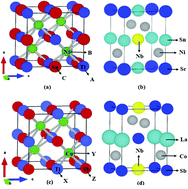Thermal, electronic and thermoelectric properties of TiNiSn and TiCoSb based quaternary half Heusler alloys obtained from ab initio calculations
Abstract
The theoretical analysis of the effect of multi-site substitution based on the 18 valence electron count (VEC) rule on the electrical, thermal and thermoelectric properties of two well known half Heusler (HH) alloys, TiNiSn and TiCoSb, are reported. Structural optimization and electronic structure calculations were performed for 54 quaternary substituted HH alloys using the projected augmented wave method and the thermoelectric properties were investigated using the full potential linearized augmented plane wave method, with semi-classical Boltzmann transport theory, using the constant relaxation time approximation. From the band structure calculations, we show that using the multi-site substitution of nonisoelectronic atoms with 18 VEC one can also design new semiconducting HH alloys and tune the bandgap and electronic structure and hence the transport properties. The substituted systems create inhomogeneity in the lattice and more phonon scattering centres due to the presence of a large mass difference of the substituted atoms with those in the host lattice and hence lower the thermal conductivity. As a result, it is expected to improve the thermoelectric figure of merit (ZT). The selected quaternary systems such as Sc0.5Nb0.5NiSn show a maximum ZT value of 0.5 at 700 K. The calculated phonon spectra and heat capacity show that the substitution at Ti and Sn sites in TiNiSn and Ti and Sb sites in TiCoSb introduces more optical–acoustic band mixing, which results in more acoustic–optical phonon–phonon scattering that is expected to lower the thermal conductivity. From the calculated power factor as a function of chemical potential (μ) we have identified optimal p-type or n-type doping levels to achieve maximum ZT and this will provide the guidance to experimentalists to identify appropriate compositions to synthesize higher efficiency thermoelectric (TE) materials. Based on the calculated results we show that there is a lot of potential for designing HH alloys with high ZT by nonisoelectronic multinary substitution.



 Please wait while we load your content...
Please wait while we load your content...